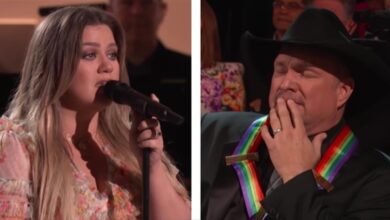LeAnn Rimes Infuses Deep Sadness Into Her Rendition Of “He Stopped Loving Her Today”
In the vast landscape of country music, few songs evoke as much emotion and personal connection as “’Til a Tear Becomes a Rose,” the memorable duet between Keith Whitley and Lorrie Morgan. This poignant piece, first recorded by Leon Everette in 1985 but significantly reinterpreted by Whitley and Morgan in 1990, stands as a testimony to both the artists’ deep emotional resonance and their intertwined personal lives. The song emerged shortly after Whitley’s untimely death in 1989, and the addition of Morgan’s voice lends it an air of bittersweet nostalgia, making it a hallmark of emotional expression within the genre.
Keith Whitley established himself in the country music pantheon through a combination of a hauntingly soulful voice and an authentic storytelling ability. His artistry allowed him to convey the complex layers of human emotion, inviting listeners to join him on a journey through love, heartbreak, and loss. Songs like “Don’t Close Your Eyes,” which became an anthem of heartbreak and resilience, display Whitley’s ability to reach deep within the emotional spectrum. He garnered immense respect in the late 1980s for his innovative approach to country music, drawing inspiration from traditional roots while pushing the genre’s boundaries.
Lorrie Morgan, who would become a defining voice for women in country music, catapulted to fame around the same time with her distinctive sound and powerful stage presence. Known for hits such as “Five Minutes” and “What Part of No,” she demonstrated a remarkable capacity to evoke emotion through her performances. Morgan’s connection to Whitley added not only depth to her artistry but also infused their collaborative efforts with genuine emotion, as their shared life experiences resonated through their music.
The duet “’Til a Tear Becomes a Rose” captures the essence of love infused with sorrow, depicting a relationship that remains resilient despite hardships. The lyrics weave a narrative of promise amidst grief, illustrating how bonds are tested yet can emerge stronger. Whitley and Morgan’s harmonious blend serves not only as an artistic accomplishment but also as a real-life portrayal of their dedication to one another, enhancing the depth of the song’s message. This particular aspect makes the song resonate deeply with audiences, allowing listeners to connect their own experiences of love and loss to the narrative unfolding in the music.
Following its 1990 release, the song managed to carve out a lasting legacy, staying relevant in the hearts of fans long after Whitley’s death. The emotional weight it carries has inspired countless artists to pay homage to the powerful nature of the piece, illustrating its significant influence on both past and present generations of country musicians. Not just confined to Whitley’s and Morgan’s repertoires, the song has been covered in various styles and settings, proving its universal appeal and relatable themes.
A particularly touching moment in the song’s legacy was when Lorrie Morgan performed “’Til a Tear Becomes a Rose” alongside her son, Jesse Keith Whitley, in 2013. This performance not only highlighted the generational impact of the song but also emphasized the familial ties that run deep within the music. It was a testament to the enduring nature of the artistic spirit that Whitley and Morgan exemplified, reminding audiences of the importance of legacy, continuity, and the emotional bonds that music can help preserve.
The emotional landscape portrayed in “’Til a Tear Becomes a Rose” also serves as a powerful platform for discussions surrounding grief and healing. Many fans have shared how the song brought solace during difficult times, reinforcing music’s role as a therapeutic outlet. The lyrics resonate deeply with anyone grappling with their own experiences of love lost and found, illustrating the healing power of connection and understanding among individuals.
The recording industry in the late 1980s and early 1990s was evolving, and the Whitley-Morgan collaboration represented an important shift. It reflected a growing acceptance of emotional storytelling within the genre, paving the way for future collaborations that harnessed the authentic expressions of love and loss that characterize so much of country music today. This endeavor set a precedent for the emotional authenticity that is now prevalent in countless duets across the genre, creating a lasting impact on how stories are woven together through song.
As one reflects on “’Til a Tear Becomes a Rose,” it becomes clear that the duet transcends its musical boundaries to become a shared experience of love, loss, and resilience. It captures the essence of a life entwined with joy and heartbreak, crafting an emotional narrative that reverberates deeply. Keith Whitley and Lorrie Morgan, through their artistic collaboration, created something eternal—a piece of music that reminds us of the fragility of love and the strength it can provide during times of sorrow.
In conclusion, the legacy of “’Til a Tear Becomes a Rose” cannot be understated. It stands as a vibrant chapter in the annals of country music history, a touching reflection of a unique love story that has left an indelible mark on listeners and artists alike. The emotional depth captured by Whitley and Morgan continues to resonate through the tapestry of country music, enriching the genre and celebrating the enduring connections that music fosters. As fans continue to embrace and revisit this heartfelt duet, the profound impact of their voices and the story they portray remains a cherished aspect of country music’s evolution, connecting generations through shared experiences of love and loss.





